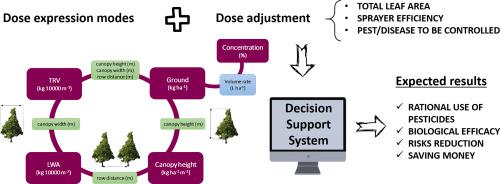Science of the Total Environment ( IF 8.2 ) Pub Date : 2021-09-16 , DOI: 10.1016/j.scitotenv.2021.150357 Santiago Planas 1 , Carla Román 2 , Ricardo Sanz 2 , Joan Ramon Rosell-Polo 2

|
Authorities around the world have committed to limiting the use of chemical pesticides by reducing doses, among other strategies. Nevertheless, different dose expression models and decision support systems (DSSs) for dose adjustment coexist for high growing crops (3D crops). Among them, leaf wall area (LWA) and tree row volume (TRV) models have recently been proposed by the European and Mediterranean Plant Protection Organization (EPPO) for pre-registration trials. In this paper, the background and technical bases of six dose adjustment DSSs in fruit crops (PACE, AGMET, DOSA3D, OMAX and PULVARBO) and four in grape orchards (AGMET, OPTIDOSE, DOSAVIÑA and DOSA3D) are described and compared. The discussion leads to the conclusion that LWA and TRV represents a substantial improvement compared to the former crop ground area-based dose expression model. However, total leaf area is the most important parameter for dose adjustment, while sprayer efficiency is also a key factor. Additionally, it is suggested that deposition on leaves (mean values and variability) should be reported in pesticide efficacy evaluations in order to establish the required doses independently from the dose expression mode. The DOSA3D system, based on leaf area index estimation, was found to be the most conservative DSS regarding the spraying volume ratio to TRV because low spraying efficiencies are considered. Instead, AGMET was found to be the most effective for dose adjustment. However, despite the differences between the recommendations, all the analysed DSSs are useful tools for rational decision making about spraying volume rate and pesticide doses at national level. Their use should be promoted by the competent authorities.
中文翻译:

3D作物农药剂量表达和调整的基础以及决策支持系统的比较
世界各地的当局已承诺通过减少剂量等策略来限制化学农药的使用。然而,对于高生长作物(3D 作物),不同的剂量表达模型和用于剂量调整的决策支持系统 (DSS) 并存。其中,叶壁面积(LWA)和树行体积(TRV)模型最近被欧洲和地中海植物保护组织(EPPO)提出用于预注册试验。本文描述和比较了水果作物中六种剂量调整 DSS(PACE、AGMET、DOSA3D、OMAX 和 PULVARBO)和葡萄园中四种剂量调节 DSS(AGMET、OPTIDOSE、DOSAVIÑA 和 DOSA3D)的背景和技术基础。讨论得出的结论是,LWA 和 TRV 与之前的基于作物地面面积的剂量表达模型相比有了实质性的改进。然而,总叶面积是调整剂量的最重要参数,而喷雾器效率也是一个关键因素。此外,建议在农药功效评估中报告叶片上的沉积物(平均值和变异性),以便独立于剂量表达模式建立所需的剂量。发现基于叶面积指数估计的 DOSA3D 系统是关于喷洒体积与 TRV 的比率最保守的 DSS,因为考虑了低喷洒效率。相反,发现 AGMET 对剂量调整最有效。然而,尽管建议之间存在差异,但所有分析的 DSS 都是在国家层面对喷洒量和农药剂量做出合理决策的有用工具。











































 京公网安备 11010802027423号
京公网安备 11010802027423号